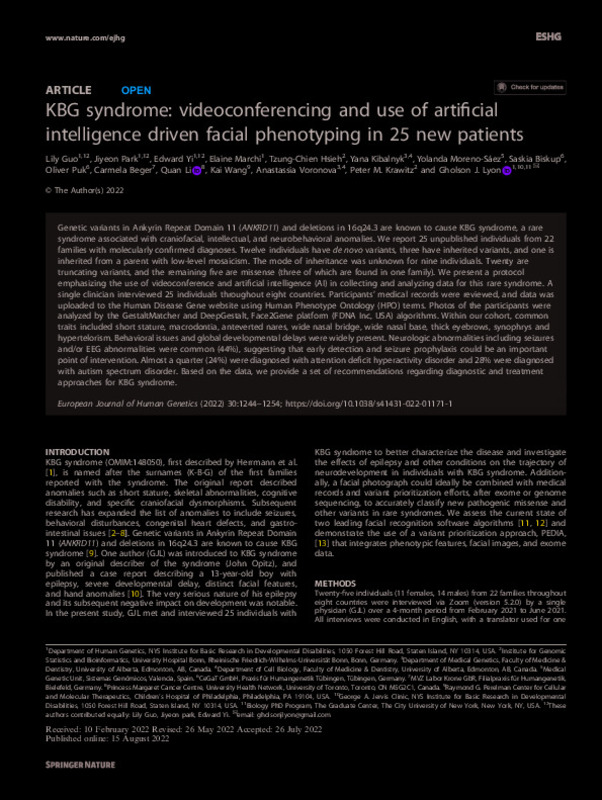JavaScript is disabled for your browser. Some features of this site may not work without it.
Buscar en RiuNet
Listar
Mi cuenta
Estadísticas
Ayuda RiuNet
Admin. UPV
KBG syndrome: videoconferencing and use of artificial intelligence driven facial phenotyping in 25 new patients
Mostrar el registro sencillo del ítem
Ficheros en el ítem
| dc.contributor.author | Guo, Lily
|
es_ES |
| dc.contributor.author | Park,Jiyeon
|
es_ES |
| dc.contributor.author | Yi, Edward
|
es_ES |
| dc.contributor.author | Marchi, Elaine
|
es_ES |
| dc.contributor.author | Hsieh, Tzung-Chien
|
es_ES |
| dc.contributor.author | Kibalnyk, Yana
|
es_ES |
| dc.contributor.author | Moreno-Sáez, Yolanda
|
es_ES |
| dc.contributor.author | Biskup, Saskia
|
es_ES |
| dc.contributor.author | Puk, Oliver
|
es_ES |
| dc.contributor.author | Beger, Carmela
|
es_ES |
| dc.contributor.author | Li, Quan
|
es_ES |
| dc.contributor.author | Wang, Kai
|
es_ES |
| dc.contributor.author | Voronova, Anastassia
|
es_ES |
| dc.contributor.author | Krawitz, Peter M.
|
es_ES |
| dc.contributor.author | Lyon, Gholson J.
|
es_ES |
| dc.date.accessioned | 2024-01-18T19:01:25Z | |
| dc.date.available | 2024-01-18T19:01:25Z | |
| dc.date.issued | 2022-11 | es_ES |
| dc.identifier.uri | http://hdl.handle.net/10251/202025 | |
| dc.description.abstract | [EN] Genetic variants in Ankyrin Repeat Domain 11 (ANKRD11) and deletions in 16q24.3 are known to cause KBG syndrome, a rare syndrome associated with craniofacial, intellectual, and neurobehavioral anomalies. We report 25 unpublished individuals from 22 families with molecularly confirmed diagnoses. Twelve individuals have de novo variants, three have inherited variants, and one is inherited from a parent with low-level mosaicism. The mode of inheritance was unknown for nine individuals. Twenty are truncating variants, and the remaining five are missense (three of which are found in one family). We present a protocol emphasizing the use of videoconference and artificial intelligence (AI) in collecting and analyzing data for this rare syndrome. A single clinician interviewed 25 individuals throughout eight countries. Participants' medical records were reviewed, and data was uploaded to the Human Disease Gene website using Human Phenotype Ontology (HPO) terms. Photos of the participants were analyzed by the GestaltMatcher and DeepGestalt, Face2Gene platform (FDNA Inc, USA) algorithms. Within our cohort, common traits included short stature, macrodontia, anteverted nares, wide nasal bridge, wide nasal base, thick eyebrows, synophrys and hypertelorism. Behavioral issues and global developmental delays were widely present. Neurologic abnormalities including seizures and/or EEG abnormalities were common (44%), suggesting that early detection and seizure prophylaxis could be an important point of intervention. Almost a quarter (24%) were diagnosed with attention deficit hyperactivity disorder and 28% were diagnosed with autism spectrum disorder. Based on the data, we provide a set of recommendations regarding diagnostic and treatment approaches for KBG syndrome. | es_ES |
| dc.description.sponsorship | This research was supported in part by funds provided to GJL from the New York State Office for People with Developmental Disabilities and NIH NIGMS R35-GM133408, and also a University of Alberta Hospital Foundation Gilbert K. Winter grant awarded to AV and Women and Children Hospital Research Institute scholarship awarded to YK. KW is supported by NIH/NLM grant LM012895. | es_ES |
| dc.language | Inglés | es_ES |
| dc.publisher | Nature Publishing Group | es_ES |
| dc.relation.ispartof | European Journal of Human Genetics | es_ES |
| dc.rights | Reconocimiento (by) | es_ES |
| dc.subject | KBG syndrome | es_ES |
| dc.subject | ANKRD11 | es_ES |
| dc.subject | Facial recognition | es_ES |
| dc.title | KBG syndrome: videoconferencing and use of artificial intelligence driven facial phenotyping in 25 new patients | es_ES |
| dc.type | Artículo | es_ES |
| dc.identifier.doi | 10.1038/s41431-022-01171-1 | es_ES |
| dc.relation.projectID | info:eu-repo/grantAgreement/NIH//LM012895/ | es_ES |
| dc.relation.projectID | info:eu-repo/grantAgreement/NIGMS//R35-GM133408/ | es_ES |
| dc.rights.accessRights | Abierto | es_ES |
| dc.description.bibliographicCitation | Guo, L.; Park, J.; Yi, E.; Marchi, E.; Hsieh, T.; Kibalnyk, Y.; Moreno-Sáez, Y.... (2022). KBG syndrome: videoconferencing and use of artificial intelligence driven facial phenotyping in 25 new patients. European Journal of Human Genetics. 30(11):1244-1254. https://doi.org/10.1038/s41431-022-01171-1 | es_ES |
| dc.description.accrualMethod | S | es_ES |
| dc.relation.publisherversion | https://doi.org/10.1038/s41431-022-01171-1 | es_ES |
| dc.description.upvformatpinicio | 1244 | es_ES |
| dc.description.upvformatpfin | 1254 | es_ES |
| dc.type.version | info:eu-repo/semantics/publishedVersion | es_ES |
| dc.description.volume | 30 | es_ES |
| dc.description.issue | 11 | es_ES |
| dc.identifier.eissn | 1018-4813 | es_ES |
| dc.identifier.pmid | 35970914 | es_ES |
| dc.identifier.pmcid | PMC9626563 | es_ES |
| dc.relation.pasarela | S\471659 | es_ES |
| dc.contributor.funder | University Hospital Foundation | es_ES |
| dc.contributor.funder | National Institutes of Health, EEUU | es_ES |
| dc.contributor.funder | Women and Children's Health Research Institute | es_ES |
| dc.contributor.funder | National Institute of General Medical Sciences, EEUU | es_ES |
| dc.contributor.funder | New York State Office for People With Developmental Disabilities | es_ES |








